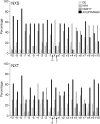An analysis of amino acid sequences surrounding archaeal glycoprotein sequons
- PMID: 17350928
- PMCID: PMC2686383
- DOI: 10.1155/2006/510578
An analysis of amino acid sequences surrounding archaeal glycoprotein sequons
Abstract
Despite having provided the first example of a prokaryal glycoprotein, little is known of the rules governing the N-glycosylation process in Archaea. As in Eukarya and Bacteria, archaeal N-glycosylation takes place at the Asn residues of Asn-X-Ser/Thr sequons. Since not all sequons are utilized, it is clear that other factors, including the context in which a sequon exists, affect glycosylation efficiency. As yet, the contribution to N-glycosylation made by sequon-bordering residues and other related factors in Archaea remains unaddressed. In the following, the surroundings of Asn residues confirmed by experiment as modified were analyzed in an attempt to define sequence rules and requirements for archaeal N-glycosylation.
Figures

References
-
- Abu-Qarn M., Eichler J. Protein N-glycosylation in Archaea: defining Haloferax volcanii genes involved in S-layer glycoprotein glycosylation. Mol. Microbiol. 2006;61:511–525. - PubMed
-
- Ben-Dor S., Esterman N., Rubin E., Sharon N. Biases and complex patterns in the residues flanking protein N-glycosylation sites. Glycobiology. 2004;14:95–101. - PubMed
-
- Brockl G., Behr M., Fabry S., Hensel R., Kaudewitz H., Biendl E., Konig H. Analysis and nucleotide sequence of the genes encoding the surface-layer glycoproteins of the hyperthermophilic methanogens Methanothermus fervidus and Methanothermus sociabilis . Eur. J. Biochem. 1991;199:147–152. - PubMed
Publication types
MeSH terms
Substances
LinkOut - more resources
Full Text Sources
Research Materials

